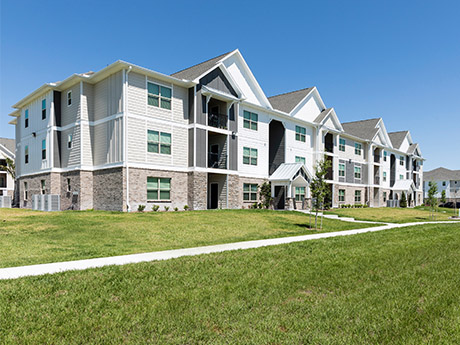Orlando is one of the country’s most active residential markets today — a modern-day “boomtown” experiencing rapid growth on multiple fronts. Economic expansion, population gains and infrastructure investments are fueling job creation and housing demand.

Multifamily developers have responded with an unprecedented range of new affordable, middle-market and luxury housing options. Young professionals, retirees, urbanites, suburbanites, digital nomads and long-term residents can each find something to suit their lifestyles and budgets thanks to a diverse mix of residential settings and price points across the Central Florida region.
Economic drivers
Orlando has attracted more people and created more jobs than any other U.S. metro over the past year. In 2024, Orlando led the nation in job growth, adding more than 37,500 jobs, according to the Florida Department of Commerce. Major projects, such as Universal Studios’ Epic Universe, Walt Disney World’s expansion, the Lake Nona Town Center build-out and Westcourt (the Orlando Magic’s Sports and Entertainment District) are expected to bring another 60,900 jobs by 2027. The growing healthcare, education and tech sectors are bringing greater balance to the economy; more than 80 percent of the local workforce is employed outside of hospitality and leisure, according to the Orlando Economic Partnership.

Orlando also led the nation in population growth between 2023 and 2024, and expects 64,800 more residents this year. Many come from other states, but Orlando is now the No.1 city for Floridians relocating, according to research from moveBuddha. High quality of life and relative housing affordability compared to the state’s coastal markets is driving demand, while the Brightline commuter train, which saw its Orlando-to- Miami ridership skyrocket last year, is fostering greater workforce mobility. It’s becoming commonplace for people to live in Orlando and commute to their jobs in South Florida.
To accommodate the surge in demand, developers are delivering new hotels, retail centers and large-scale, master-planned communities at a record pace. Orange County is preparing for an expected 500,000 or more new residents over the next 25 years, according to Vision2050, a newly adopted plan to guide future development that prioritizes affordability, the preservation of green space and new development steered toward high-population areas like International Drive.
Fundamentals strengthen
Orlando’s supply wave crested last year with more than 14,000 new units, causing both rent growth and occupancy to dip. Given current demand-supply trends, most estimates suggest rent growth will return later in the year or by early 2026.
In 2025, there are roughly 10,000 units on track for delivery, with absorption forecast to keep pace. In May, rents had declined 1.3 percent year-over-year, according to Apartment List. As new deliveries taper off early, Orlando could see rents grow as much as 3.9 percent, to $1,802 per month, by year-end. However, a slower-than-expected rebound may stem from lingering supply overhang, broader economic uncertainty, or both — factors also dampening multifamily transaction activity in 2025.
On the upside, that uncertainty has boosted resident retention, which benefits operators; occupancy is expected to rise 50 basis points to 93.8 percent by year-end.
Emerging markets
Beyond Orlando’s core, investors and developers are eyeing nearby markets with strong demand drivers and historically low inventory.
For example, Ocala — 75 miles north — has become a top destination over the last several years, landing near the top of PODS’ 2025 moving trends list. In addition to being a world-class equestrian center, its appeal stems from its relative affordability and proximity to The Villages, the world’s largest 55+ community — and one of only three markets in Florida where home sales actually increased year over year, according to May Florida Realtors data.
Demand from this community is spilling over into neighboring Leesburg and Lake County, where The Villages is expanding and other investors are following suit.
Meanwhile, an hour east of Orlando, economic expansion on the Space Coast, where employers like Lockheed Martin and Northrup Grumman are creating thousands of new jobs, is also boosting demand for housing. From Cocoa Beach to Melbourne and Palm Bay, multifamily investors are developing new communities or acquiring value-add assets to address the undersupply and long-term demand trends.
An abundance of land and pro-growth policies have also made Central Florida an ideal setting for single-family rental (SFR) and build-to-rent (BTR) development. Large homebuilders and landowners are either launching BTR divisions, partnering with multifamily investors or selling communities to investors, including large institutional groups.
Capital markets trends
While the capital markets remain challenging, Central Florida’s market fundamentals and long-term outlook are encouraging buyers to re-engage. There’s been a flight to quality, with many investors focusing on newer vintage (post-2017) assets with potential for value-add execution, particularly in high-growth corridors. Buying near or below replacement cost in high-conviction locations is now seen as a more attractive play, given the higher cost of capital and rising labor and materials costs. In this environment, strong and experienced operators have the best chance at success — and submarket appeal is more important than ever.
According to MSCI Real Capital Analytics, reported multifamily sales in the Orlando MSA year-to-date (January 1 to June 24) totaled $599.94 million, down 14.2 percent compared to the same period last year. Active investors in Central Florida this year include TruAmerica Multifamily, Greystar Real Estate Partners and Ashcroft Capital. Bell Partners led the largest multifamily transaction so far this year — and the largest since 2022 — by acquiring the 484-unit Bell Avalon Park in East Orlando in May for $137 million.
To sum it all up, Orlando’s central location, geographic diversity, relative affordability and modern transportation infrastructure have made it a magnet for both businesses and people. The region entered a new phase of growth after 2020, with new developments reshaping the urban core, and bringing high-quality multifamily housing options for the first time to rural pockets like Apopka and Leesburg.
With job creation outpacing national averages and demand poised to absorb the new supply, Central Florida is poised for continued strength across both the multifamily and SFR/BTR sectors.
— By Cole Whitaker, Senior Managing Director, and Brett Moss, Managing Director, Berkadia. This article was originally published in the July 2025 issue of Southeast Real Estate Business.


